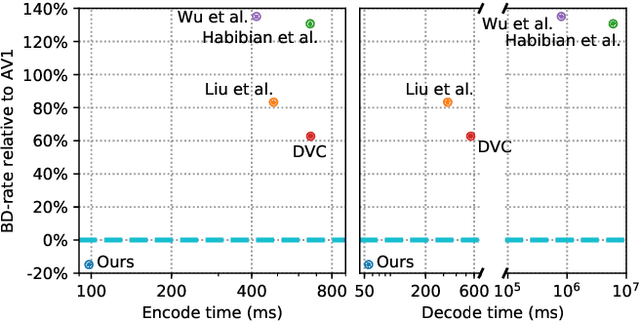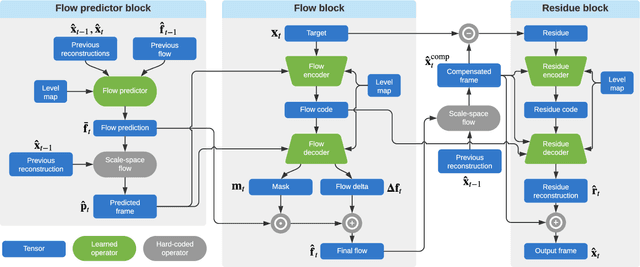Sanjay Nair
ELF-VC: Efficient Learned Flexible-Rate Video Coding
Apr 29, 2021



Abstract:While learned video codecs have demonstrated great promise, they have yet to achieve sufficient efficiency for practical deployment. In this work, we propose several novel ideas for learned video compression which allow for improved performance for the low-latency mode (I- and P-frames only) along with a considerable increase in computational efficiency. In this setting, for natural videos our approach compares favorably across the entire R-D curve under metrics PSNR, MS-SSIM and VMAF against all mainstream video standards (H.264, H.265, AV1) and all ML codecs. At the same time, our approach runs at least 5x faster and has fewer parameters than all ML codecs which report these figures. Our contributions include a flexible-rate framework allowing a single model to cover a large and dense range of bitrates, at a negligible increase in computation and parameter count; an efficient backbone optimized for ML-based codecs; and a novel in-loop flow prediction scheme which leverages prior information towards more efficient compression. We benchmark our method, which we call ELF-VC (Efficient, Learned and Flexible Video Coding) on popular video test sets UVG and MCL-JCV under metrics PSNR, MS-SSIM and VMAF. For example, on UVG under PSNR, it reduces the BD-rate by 44% against H.264, 26% against H.265, 15% against AV1, and 35% against the current best ML codec. At the same time, on an NVIDIA Titan V GPU our approach encodes/decodes VGA at 49/91 FPS, HD 720 at 19/35 FPS, and HD 1080 at 10/18 FPS.
Learned Video Compression
Nov 16, 2018



Abstract:We present a new algorithm for video coding, learned end-to-end for the low-latency mode. In this setting, our approach outperforms all existing video codecs across nearly the entire bitrate range. To our knowledge, this is the first ML-based method to do so. We evaluate our approach on standard video compression test sets of varying resolutions, and benchmark against all mainstream commercial codecs, in the low-latency mode. On standard-definition videos, relative to our algorithm, HEVC/H.265, AVC/H.264 and VP9 typically produce codes up to 60% larger. On high-definition 1080p videos, H.265 and VP9 typically produce codes up to 20% larger, and H.264 up to 35% larger. Furthermore, our approach does not suffer from blocking artifacts and pixelation, and thus produces videos that are more visually pleasing. We propose two main contributions. The first is a novel architecture for video compression, which (1) generalizes motion estimation to perform any learned compensation beyond simple translations, (2) rather than strictly relying on previously transmitted reference frames, maintains a state of arbitrary information learned by the model, and (3) enables jointly compressing all transmitted signals (such as optical flow and residual). Secondly, we present a framework for ML-based spatial rate control: namely, a mechanism for assigning variable bitrates across space for each frame. This is a critical component for video coding, which to our knowledge had not been developed within a machine learning setting.
 Add to Chrome
Add to Chrome Add to Firefox
Add to Firefox Add to Edge
Add to Edge